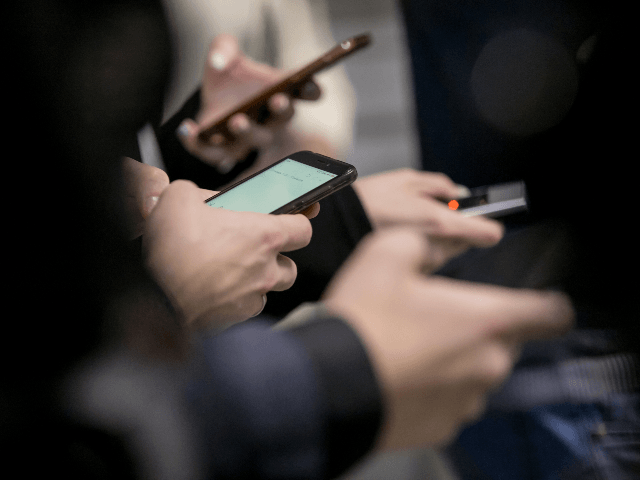Chinese media outlets import numerous journalists into the United States via the H-1B program, usually at very low salaries.
The imported visa-workers’ wages are as low as $33,000 per year – despite the large number of Americans seeking journalist careers – according to federal data collected by MyVisaJobs.com.
MyVisaJobs.com uses federal data to track job opportunities for foreign graduates in the United States. The data shows that employers nationwide nominated 11,153 Chinese-born migrants for green cards in 2019; 12,612 in 2018; 8,603 in 2017; and 7,217 in 2016. Overall, 59,870 Chinese has been nominated for green cards since 2010 by U.S. employers. Nearly all of those requests are approved by the government, after a short delay.
On March 17, Chinese media outlets announced that China’s government is pushing roughly 13 U.S. journalists out of China:
China demands that journalists of US citizenship working with the New York Times, the Wall Street Journal and the Washington Post whose press credentials are due to expire before the end of 2020 notify the Department of Information of the Ministry of Foreign Affairs within four calendar days starting from today and hand back their press cards within ten calendar days. They will not be allowed to continue working as journalists in the People’s Republic of China, including its Hong Kong and Macao Special Administrative Regions.
On March 18, China made more threats against American journalists, Reuters reported:
Chinese foreign ministry spokesman Geng Shuang also warned that China would be compelled to take further action against American media and journalists in China if the United States did not “correct its mistakes”.
“The U.S. has said that all options are on the table. Today, I can also tell the U.S. that all options are on the table for China,” Geng told a regular daily press briefing.
“The expulsion is expected to affect at least 13 journalists, according to the Foreign Correspondents Club of China, which said it ‘deplores’ China’s decision,” Reuters reported.
The MyVisaJobs data shows the many requests for H-1B workers in 2019, 2018, and 2017 by China-run outlets, as well as by U.S. media companies that hire Chinese workers:
- Xinhuanet North America Corporation asked for five H-1Bs in 2019, at an average wage of $82,400.
- Xinhua Book Store USA Corp. sought four H-1Bs and a green card for one employee who is being paid just $43,000.
- Sinovision Inc., asked for 68 H-1Bs, at a wage between $34,800 and $50,700.
- Chinese Information Radio sought one H-1B for an employee to be paid $42,000.
- Backchina sought 10 workers at an average of roughly $33,000.
- Sino Television Inc., sought seven H-1Bs, at an average wage of $33,000.
- Pacific Culture Enterprise Inc., asked for 34 H-1Bs, at an average wage of roughly $40,000. The company reportedly includes the China Press.
- World Journal Llc. sought 54 H-1Bs between $35,00 and $62,000. The company produces Chinese-language newspapers.
- Zhong Want TV Inc. sought seven H-1Bs.
Some of the media outlets are privately owned – even though they import journalists from China.
Huopai Media Inc. sought ten H-1Bs, at wages from $48,000 to $52,500. The company has apparently been threatened by the Chinese government, according to the Washington Post.
“China’s transnational operation to suppress free speech and influence international public opinion is equally significant, extending to Chinese American communities as well as to the mainstream U.S. media,” the Post reported.
Sing Tao Newspapers New York asked for 25 H-1Bs, at an average wage of $36,000. The company is an affiliate of a Hong Kong newspaper.
Careless US estb. lets China hire thousands of scientists in the US, incl. many employed by US taxpayers, to steal tech by the boatload, admits (far too late) bipartisan Senate report.
No gov't or Ivy League managers are fired.
No visa program is frozen.https://t.co/cEunR3gpBn— Neil Munro (@NeilMunroDC) November 23, 2019
Many additional Chinese workers can be imported via the Occupational Practical Training program. These workers must first get a technology-related degree from a U.S. university and can work for up to three years, even if they are paid very low wages.
In 2018, almost 480,000 Chinese students were registered in the United States. Also, 25,843 Chinese graduates got work-permits via the ‘STEM’ side of the Optional Training Program.
Many American outlets and trade associations import foreigners to work as journalists in the United States.
Bloomberg, for example, asked for 14 journalists since 2017, plus several hundred software experts. Marketing agencies and advertising firms also hired many foreigners instead of Americans.
Each year, roughly 40 percent of the requests for H-1Bs are approved by the federal government. Once imported, the H-1B workers can stay for roughly six years. However, U.S. companies can sponsor their foreign H-1B employees for green cards. There is no limit to the number of foreign employees who can be nominated each year. Once nominated the employees can continue extending their work permits.
This extension rule has created a domestic workforce of roughly 350,000 Indian computer-workers who have been imported by many American companies.
Online searches show why Microsoft & Amazon are concerned re #CoronaVirus: Each employs 6,000+ China-born graduates.
They got the high-$$ jobs via H-1B & OPT visas. Many have green cards.
Surely this cannot have any impact at all on US grads' salaries. https://t.co/x96whGFVm7— Neil Munro (@NeilMunroDC) January 31, 2020

COMMENTS
Please let us know if you're having issues with commenting.